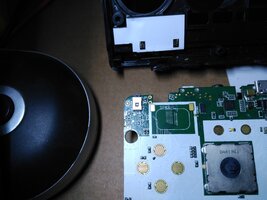asimov-solensan
Very Active Member
- Joined
- Jan 8, 2010
- Messages
- 746
I don't know what is the cause because a few things happened before I noticed.
First, yesterday afternoon my Pyra fell from bed. It was a minor hit but one of the shoulder buttons got stuck in the housing. I don't remember if it was L2 or R2 but it was one of the bigger ones.
Ok so I disassembled, put the button in place and booted the unit. Since it loaded the OS I just shut it down and forgot about it. The feedback of all shoulder buttons was fine but didn't tested the functionality.
Later that night I booted the unit and since I was in bed and it was dark I'm almost sure I enabled keyboard light using L1+brightness. I'm almost sure because that is the natural combination when thumb typing. If it failed at this point I think I would have noticed.
Then I tried installing anbox form apt and it upgraded several packages at the same time. After checking that anbox service does not work and confirming it requires the kernel to be compiled with a couple of additional modules I gave up. I tried to disable the keyboard light to watch a video and at this point is when I noticed the L1 wasn't working.
The FN function works with the right button but not with left FN/L1. Also if I run xev the keypress does not register any event.
Now I wonder if it is a phisical problem or caused by the upgraded packages. Any suggestions on what to check now?
First, yesterday afternoon my Pyra fell from bed. It was a minor hit but one of the shoulder buttons got stuck in the housing. I don't remember if it was L2 or R2 but it was one of the bigger ones.
Ok so I disassembled, put the button in place and booted the unit. Since it loaded the OS I just shut it down and forgot about it. The feedback of all shoulder buttons was fine but didn't tested the functionality.
Later that night I booted the unit and since I was in bed and it was dark I'm almost sure I enabled keyboard light using L1+brightness. I'm almost sure because that is the natural combination when thumb typing. If it failed at this point I think I would have noticed.
Then I tried installing anbox form apt and it upgraded several packages at the same time. After checking that anbox service does not work and confirming it requires the kernel to be compiled with a couple of additional modules I gave up. I tried to disable the keyboard light to watch a video and at this point is when I noticed the L1 wasn't working.
The FN function works with the right button but not with left FN/L1. Also if I run xev the keypress does not register any event.
Now I wonder if it is a phisical problem or caused by the upgraded packages. Any suggestions on what to check now?


